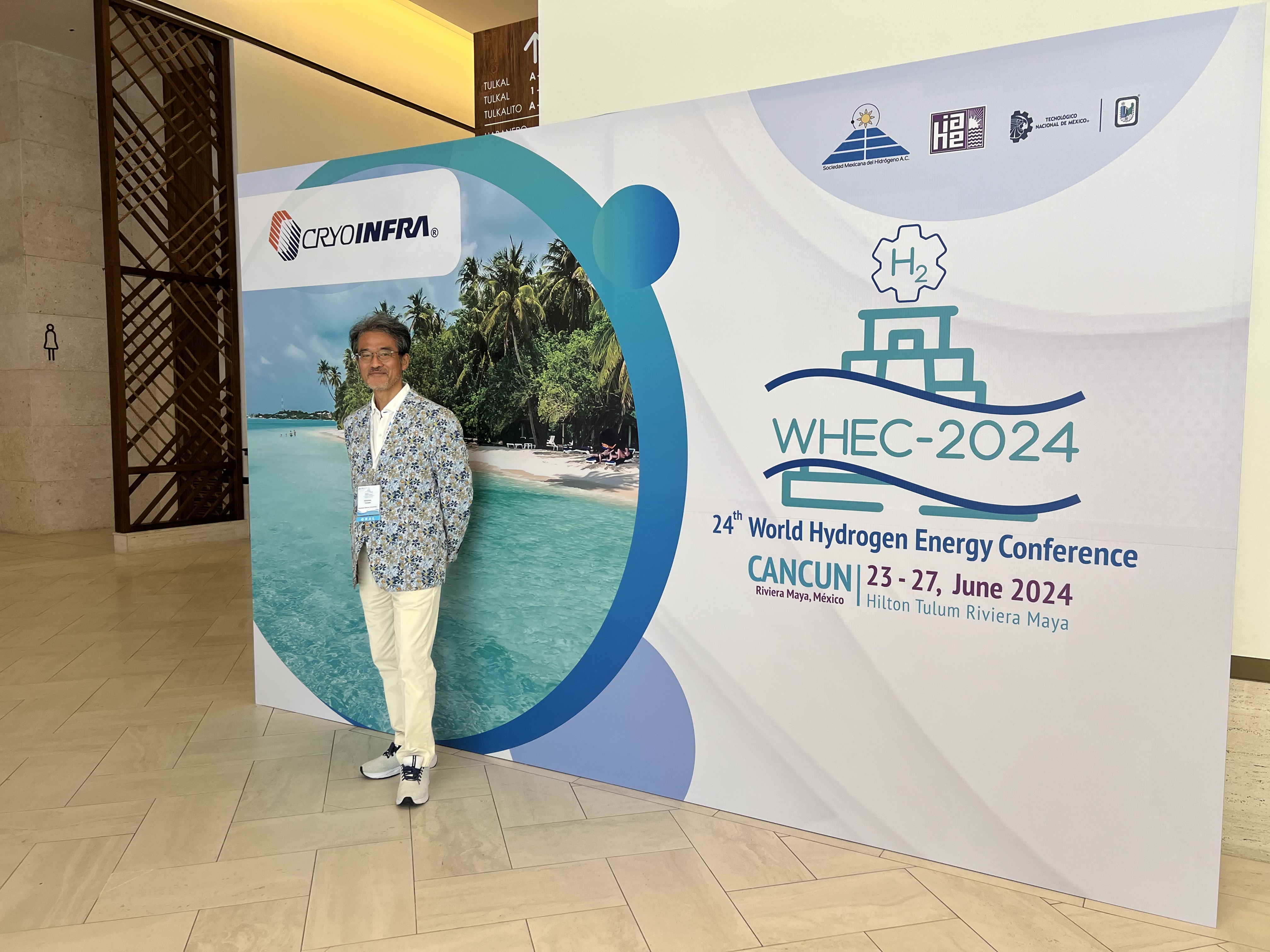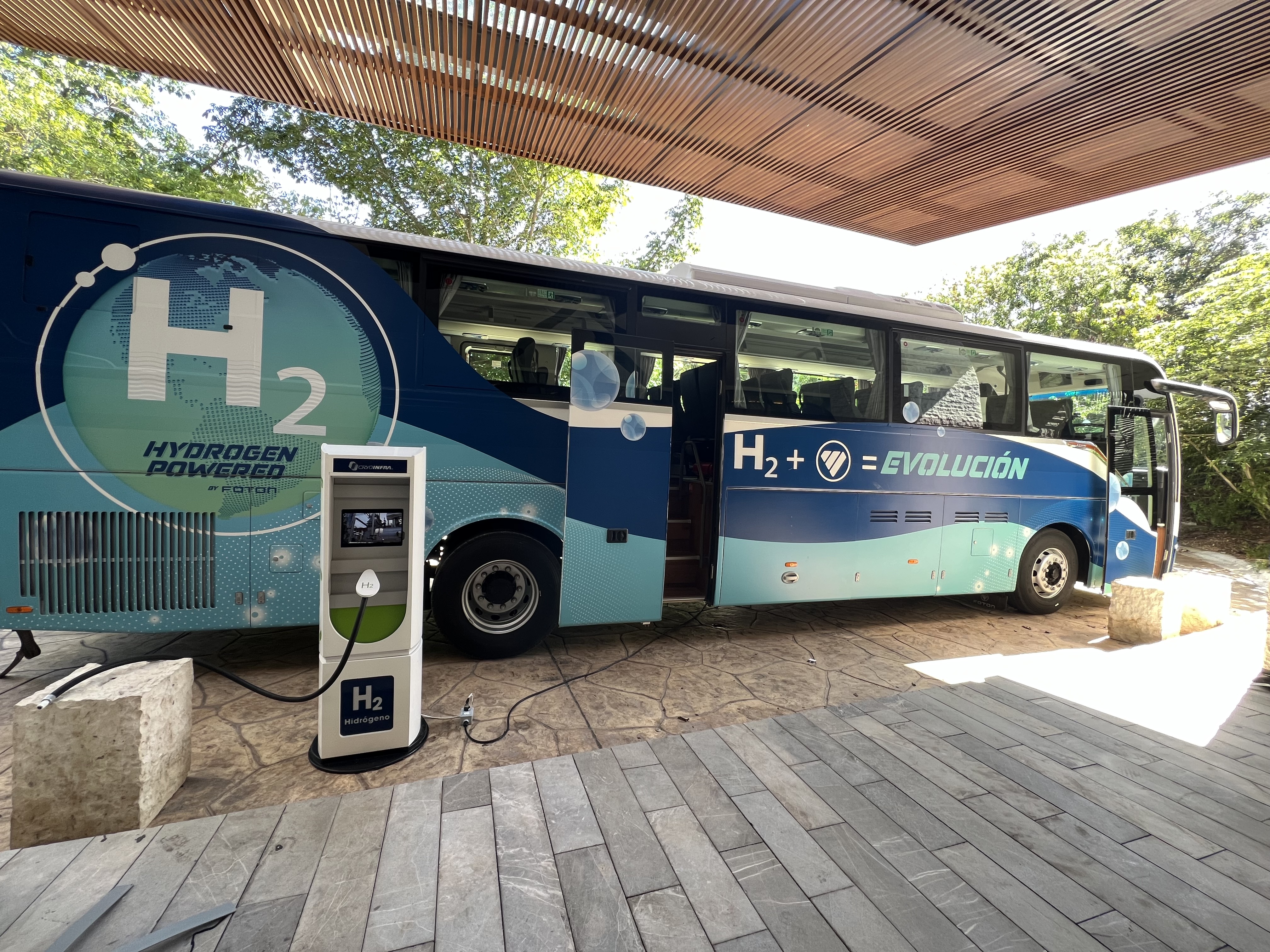田中裕久・工学部物質工学課程教授が、第24回世界水素エネルギー会議で水素安全触媒に関する2件の研究成果を発表しました
Professor Hirohisa Tanaka, Program of Materials Science, School of Engineering, gave two presentations on hydrogen safety catalysts at the 24th World Hydrogen Energy Congress.
2024.07.08
学会 Academic Conference
田中裕久・工学部物質工学課程教授が、2024年6月23日から27日までメキシコ・カンクンで開催された「the 24th World Hydrogen Energy Conference: WHEC-2024(第24回・世界水素エネルギー会議)」で水素安全触媒に関する2件の研究成果を発表しました。
WHEC-2024は、国際水素エネルギー協会 (IAHE)が主催し、the Royal Society of Chemistry、Elsevier、Japan Atomic Energy Agency (JAEA)などがスポンサーシップに名を連ね、北米、南米、欧州、アジアだけでなく、オセアニアや中東、アフリカなど世界各国から約700名の参加者を得て盛大に開催されました。
田中裕久研究室では来るべき水素社会を支える安全技術として、水素爆発を未然防止する技術開発を進めています。これは万一水素が漏洩した時に、触媒により酸素と結合し安全な水に転換することにより水素濃度を爆発限界以下に低減する技術です。
今回発表した1件目は、この触媒を液化水素の特徴である、マイナス253℃、エネルギー密度は水素ガスの800倍という環境に対応していくための研究成果を公開しました。題目は、「Experimental verification to developing safety technology for liquefied hydrogen: Project "STACY"」です。これは、JST SICORP(戦略的国際共同研究プログラム)の多国間の国際共同研究事業であるEIG CONCERT-Japanの支援を受けて日独仏の4研究室が共同で取り組んでいる「Towards Safe Storage and Transportation of Cryogenic Hydrogen (STACY)」の研究成果です。
2件目は、福島第1原子力発電所の廃炉・汚染水処理といった、復興支援技術です。題目は、「A proposal of hydrogen safety technology for decommissioning of the Fukushima Daiichi Nuclear Power Plant」です。事故を起こした原子炉の底には溶け落ちた核燃料が堆積しており、これは燃料デブリと呼ばれます。燃料デブリは冷却水の中に沈んでいる訳ですが、そこに雨水や地下水が流れ込むことにより汚染水が増え続けており、燃料デブリを取り出して別の場所で保管することが国家の大きなプロジェクトとして推進されています。この燃料デブリは収納缶の中に封じ込めて保管したいのですが、水分が残存していると燃料デブリから発する放射線によって水が水素と酸素に分解されて二次災害の危険を伴います。この収納缶内で発生する水素と酸素を触媒反応によって水に戻す技術について発表しました。
どちらの発表も注目を集め、企業や大学、研究所の方々からも質問をいただき、より詳しい情報交換をさせていただくことができました。また、旧知の研究者ともコロナ禍のインターバルを経て久々に交流を持つことができ、カーボンニュートラル社会を築くための水素のあり方について有意義な意見交換ができ、今後の研究に活かしていきたいと考えています。
WHEC-2024は、国際水素エネルギー協会 (IAHE)が主催し、the Royal Society of Chemistry、Elsevier、Japan Atomic Energy Agency (JAEA)などがスポンサーシップに名を連ね、北米、南米、欧州、アジアだけでなく、オセアニアや中東、アフリカなど世界各国から約700名の参加者を得て盛大に開催されました。
田中裕久研究室では来るべき水素社会を支える安全技術として、水素爆発を未然防止する技術開発を進めています。これは万一水素が漏洩した時に、触媒により酸素と結合し安全な水に転換することにより水素濃度を爆発限界以下に低減する技術です。
今回発表した1件目は、この触媒を液化水素の特徴である、マイナス253℃、エネルギー密度は水素ガスの800倍という環境に対応していくための研究成果を公開しました。題目は、「Experimental verification to developing safety technology for liquefied hydrogen: Project "STACY"」です。これは、JST SICORP(戦略的国際共同研究プログラム)の多国間の国際共同研究事業であるEIG CONCERT-Japanの支援を受けて日独仏の4研究室が共同で取り組んでいる「Towards Safe Storage and Transportation of Cryogenic Hydrogen (STACY)」の研究成果です。
2件目は、福島第1原子力発電所の廃炉・汚染水処理といった、復興支援技術です。題目は、「A proposal of hydrogen safety technology for decommissioning of the Fukushima Daiichi Nuclear Power Plant」です。事故を起こした原子炉の底には溶け落ちた核燃料が堆積しており、これは燃料デブリと呼ばれます。燃料デブリは冷却水の中に沈んでいる訳ですが、そこに雨水や地下水が流れ込むことにより汚染水が増え続けており、燃料デブリを取り出して別の場所で保管することが国家の大きなプロジェクトとして推進されています。この燃料デブリは収納缶の中に封じ込めて保管したいのですが、水分が残存していると燃料デブリから発する放射線によって水が水素と酸素に分解されて二次災害の危険を伴います。この収納缶内で発生する水素と酸素を触媒反応によって水に戻す技術について発表しました。
どちらの発表も注目を集め、企業や大学、研究所の方々からも質問をいただき、より詳しい情報交換をさせていただくことができました。また、旧知の研究者ともコロナ禍のインターバルを経て久々に交流を持つことができ、カーボンニュートラル社会を築くための水素のあり方について有意義な意見交換ができ、今後の研究に活かしていきたいと考えています。
Professor Hirohisa Tanaka, Program of Materials Science, School of Engineering presented two research results on hydrogen safety catalysts at the 24th World Hydrogen Energy Conference (WHEC-2024) held in Cancun, Mexico from June 23 to 27, 2024.
WHEC-2024 was organized by the International Association of Hydrogen Energy (IAHE) and sponsored by the Royal Society of Chemistry, Elsevier, Japan Atomic Energy Agency (JAEA), and was a successful event with approximately 700 participants from North and South America, Europe, Asia, Oceania, the Middle East, Africa, and other countries around the world.
The Hirohisa Tanaka Laboratory is developing technology to prevent hydrogen explosions as a safety technology to support the coming hydrogen society. This technology reduces the hydrogen concentration below the explosion limit in the event of a hydrogen leak by combining with oxygen through a catalyst and converting it into safe water.
The first paper published this time was the results of research on adapting this catalyst to the environment of -253°C, which is characteristic of liquefied hydrogen, and has an energy density 800 times that of hydrogen gas. The title is "Experimental verification to developing safety technology for liquefied hydrogen: Project "STACY"". This is the result of research on "Towards Safe Storage and Transportation of Cryogenic Hydrogen (STACY)", which is a joint project of four laboratories from Japan, Germany and France, supported by EIG CONCERT-Japan, a multinational international joint research project of the JST SICORP (Strategic International Collaborative Research Program).
The second paper is a technology to support reconstruction, such as decommissioning the Fukushima Daiichi Nuclear Power Plant and treating contaminated water. The title is "A proposal of hydrogen safety technology for decommissioning of the Fukushima Daiichi Nuclear Power Plant". At the bottom of the reactor where the accident occurred, melted nuclear fuel has accumulated, and this is called fuel debris. The fuel debris is submerged in the cooling water, but the amount of contaminated water continues to increase as rainwater and groundwater flow into it, so a major national project is being promoted to remove the fuel debris and store it elsewhere. This fuel debris would be sealed and stored in a storage canister, but if water remains, the radiation emitted from the fuel debris will decompose the water into hydrogen and oxygen, which poses the risk of secondary disasters. A technology was presented to convert the hydrogen and oxygen generated in the storage canister back into water through a catalytic reaction.
Both presentations by Professor Tanaka attracted attention, and the audience from companies, universities, and research institutes asked him questions and exchanged more detailed information. Professor Tanaka was also able to meet with old friends and researchers for the first time in a long time after the COVID-19 pandemic, and had a meaningful exchange of opinions about the role of hydrogen in building a carbon-neutral society, which he hopes to utilize in his future research.
WHEC-2024 was organized by the International Association of Hydrogen Energy (IAHE) and sponsored by the Royal Society of Chemistry, Elsevier, Japan Atomic Energy Agency (JAEA), and was a successful event with approximately 700 participants from North and South America, Europe, Asia, Oceania, the Middle East, Africa, and other countries around the world.
The Hirohisa Tanaka Laboratory is developing technology to prevent hydrogen explosions as a safety technology to support the coming hydrogen society. This technology reduces the hydrogen concentration below the explosion limit in the event of a hydrogen leak by combining with oxygen through a catalyst and converting it into safe water.
The first paper published this time was the results of research on adapting this catalyst to the environment of -253°C, which is characteristic of liquefied hydrogen, and has an energy density 800 times that of hydrogen gas. The title is "Experimental verification to developing safety technology for liquefied hydrogen: Project "STACY"". This is the result of research on "Towards Safe Storage and Transportation of Cryogenic Hydrogen (STACY)", which is a joint project of four laboratories from Japan, Germany and France, supported by EIG CONCERT-Japan, a multinational international joint research project of the JST SICORP (Strategic International Collaborative Research Program).
The second paper is a technology to support reconstruction, such as decommissioning the Fukushima Daiichi Nuclear Power Plant and treating contaminated water. The title is "A proposal of hydrogen safety technology for decommissioning of the Fukushima Daiichi Nuclear Power Plant". At the bottom of the reactor where the accident occurred, melted nuclear fuel has accumulated, and this is called fuel debris. The fuel debris is submerged in the cooling water, but the amount of contaminated water continues to increase as rainwater and groundwater flow into it, so a major national project is being promoted to remove the fuel debris and store it elsewhere. This fuel debris would be sealed and stored in a storage canister, but if water remains, the radiation emitted from the fuel debris will decompose the water into hydrogen and oxygen, which poses the risk of secondary disasters. A technology was presented to convert the hydrogen and oxygen generated in the storage canister back into water through a catalytic reaction.
Both presentations by Professor Tanaka attracted attention, and the audience from companies, universities, and research institutes asked him questions and exchanged more detailed information. Professor Tanaka was also able to meet with old friends and researchers for the first time in a long time after the COVID-19 pandemic, and had a meaningful exchange of opinions about the role of hydrogen in building a carbon-neutral society, which he hopes to utilize in his future research.




関連記事
- 2025.06.15
共同研究 Collaborative Research
学会出張 Business Trip
-
田中裕久・工学部教授が環境触媒国際会議2025で水素安全国際共同研究に関する研究成果を発表しました
Engineering, presented the results of his research on "STACY: A Japanese-German-French Joint Research Project on the Safety of Liquefied Hydrogen" at the International Conference on Environmental Catalysis (ICEC2025) - 2022.10.26
研究会 Research Meeting
-
田中裕久・工学部教授の研究室が主体となり、極低温(液化)水素の安全な貯蔵と輸送に向けた日欧国際協力に関する国際シンポジウムを開催
STACY: Towards Safe Storage and Transportation of Cryogenic Hydrogen - 2019.07.23
共同研究 Collaborative Research
-
田中裕久・理工学部教授がダイハツ工業株式会社ほかと「ハニカム型水素安全触媒」を開発
back
